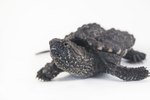
While adult crocodiles are formidable animals with few natural threats, their eggs, hatchlings and juveniles are at risk -- of marauding lizards, raccoons and other predators, not to mention of floods and other forms of bad weather such as hurricanes or droughts. While the relative success of every nest is different, a significant percentage of the eggs in each nest often survive; however, very few hatchings survive to adulthood.
Successful Hatchlings
In 1989, James A. Kushlan and Frank J. Mazzoti published a report detailing the population biology of American crocodiles in the “Journal of Herpetology.” The study, which examined historical data as well as field research, noted that between 1977 and 1980 about 78 percent of nests produced at least one viable hatchling. By extrapolating their numbers, the researchers estimated that between 42 percent and 73 percent of the crocodile eggs successfully hatch in a given year. As the researchers found that about 90 percent of the eggs were fertile, predators and climactic events eliminate between 12 and 48 percent of the eggs in a year.
Nest Predators
Many predators, such as rats, pigs and ants, opportunistically consume crocodile eggs; but a few species routinely depredate crocodile nests. In North and Central America, raccoons (Procyon spp.) are important predators of American crocodile (Crocodylus acutus) eggs. Monitor lizards (Varanus spp.) are particularly important predators of crocodile eggs; mangrove monitors (Varanus indicus), water monitors (Varanus salvator) and Nile monitors (Varanus niloticus) are capable nest robbers. Australian Gould’s monitors (Varanus gouldi) consume at least some of the eggs from 5 percent of Australian freshwater crocodile (Crocodylus johnstoni) nests.
Abiotic Causes of Mortality
Because they nest in close proximity to the water, flooding is a serious concern for crocodile eggs. According to a 1982 study by William E. Magnusson, published in the “Journal of Herpetology,” floods are the primary cause for the death of estuarine crocodile (Crocodylus porosus) eggs, despite the presence of monitor lizards. As discovered by Frank J. Mazzoti, James A. Kushlan and Ann Dunbar-Cooper in a 1988 study of American crocodiles, published in "Florida Scientist," nests can flood from subterranean groundwater that is not visible on the surface. Conversely, severe droughts can cause eggs to desiccate and die. As most crocodile species live in areas subject to hurricanes, cyclones and similar storms, the eggs are also at risk to destruction from storm surges, high winds and other factors.
Life Outside the Egg
Life does not get any easier for crocodiles once they escape the confines of their shells. While their mothers will often assist them in digging out of the nest, escort them to the water and provide some protection from predators, only about 1 percent of the hatchlings survive to adulthood. Once mature, crocodiles exhibit very low mortality -- less than 1 percent in the case of American crocodiles. While the eggs, hatchlings and juveniles are at risk to a variety of predators, adult crocodiles have very few. Larger crocodiles will prey on smaller individuals, but the primary predatory threat for adults is humans.
References
- Animal Diversity Web: Crocodylus Rhombifer
- Northern Territory: Saltwater Crocodile
- US Fish and Wildlife Service: American Crocodile (Crocodylus Acutus)
- University of Florida: Desiccation and Cryptic Nest Flooding as Probable Causes of Egg Mortality in the American Crocodile, Crocodylus Acutus, in Everglades National Park, Florida
- Journal of Herpetology: Population Biology of the American Crocodile
- Animal Biology: Nest Attendance and Hatchling Care in Wild American Crocodiles (Crocodylus Acutus) in Quintana Roo, Mexico
- Biological Journal of the Linnean Society: Ecological and Evolutionary Implications of Diet in Monitor Lizards
- Journal of Herpetology: Mortality of Eggs of the Crocodile, Crocodylus Porosus, in Northern Australia
Photo Credits
-
Anup Shah/Photodisc/Getty Images




